Sokolow Theatre/Dance Ensemble revives three Anna Sokolow works.
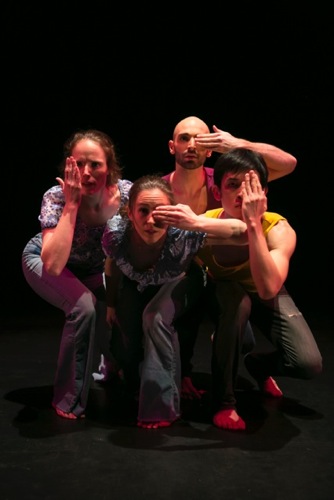
Anna Sokolow’s Ride the Culture Loop. L to R: Maya Kite, Alexandra Pfister, Richard Scandola, and I-Nam Jiemvitayanukoon. Photo: Melissa Sobel/Meem Images
I’ve told this story before, but it slid into my mind again as I left the 14th Street Y after seeing the Sokolow Dance/Theatre Ensemble perform works by Anna Sokolow dating from 1968. About a decade earlier, I, a newly minted member of Juilliard Dance Theater with a knee problem, was watching Sokolow choreograph a piece for us. She wanted the dancers to race from the back of the studio to the front and stop dead; in an actual performance, they’d come close to falling into a theater’s orchestra pit. Anna was unhappy—with their speed, their lack of intensity, and the cautious way they put on the brakes. So she picked up a chair and threw it at them. They stopped. Next rehearsal, she asked all those who were with her to stand to the right; those against her could stand to the left. We managed to calm her down and get on with the dancing.
Some years later, when I came across a snapshot of young Anna Sokolow cavorting in a swimming pool with other members of Martha Graham’s company, I couldn’t believe my eyes. Anna was laughing! Later, I got to know her better, saw her smile. But fierceness was her armor and part of her power as an artist. In an article that appeared in New York Magazine years ago, Marcia B. Siegel quoted her as saying, “I haven’t got that happy philosophy, but what the hell’s to be happy about?”
Jim May, the artistic director of Sokolow Dance/Theatre Ensemble, worked with her for 35 years and, beginning in 1980, co-directed the Players’ Project with her. He is the guardian of her heritage. The ambitious program presented at the 14th Street Y reminded me again of her approach to dance in terms of ambience, subject matter, and choreographic style. Ride the Culture Loop (1975), Steps of Silence (1968), and Kurt Weill (1988) require, respectively, twelve, ten, and eight performers. And these performers have been carefully coached. They understand that in a Sokolow work, you do not just turn your head, you TURN YOUR HEAD. As if your entire being were focused on that single act. And often they stare intently at us—calling to mind animals with a cage between them and their prey, or escaped prisoners trying to see into the darkness ahead. When they suddenly gaze toward the roof, you imagine that something deadly could rain down. Or a blessing.
Ride the Culture Loop (staged by Samantha Géracht) is set to a score by Teo Macero, a jazz composer with whom Sokolow collaborated a number of times. The dancers’ behavior calls to mind the title of David Riesman’s 1950s book The Lonely Crowd. Sometimes they herd, but often they seem alone together. One of Sokolow’s devices was to teach a short phrase of actions to everyone and then have them begin it at different points. Not only does this create a vibrant stage picture; it suggests that these people have shared customs but approach them in their own ways.
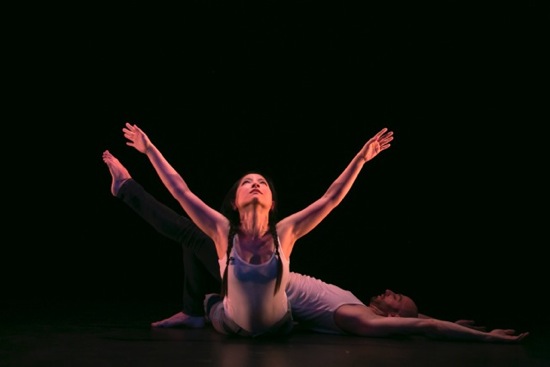
Yayoi Suzuki and Richard Scandola in Anna Sokolow’s Ride the Culture Loop. Photo: Melissa Sobel/Meems Images
There’s something crazed about this dance. People start things, drop them, begin something else. At the outset, one woman (Margherita Tisato), walks carefully across the front of the stage as if on a railroad track, trying to keep her balance. Within minutes, people who’ve clustered at the back of the stage toss another woman (Yayoi Suzuki) up in the air three times. When they separate and go their ways, they leave her in a heap. One of the men grabs her wrist, yanks her up, then walks away; she blends into the moving crowd and exits. Vanished.
The atmosphere seems to shift dangerously all the time, as if these people were always hustling to get somewhere, to see the sights, to join some trend. Lighting designer Stephen Petrilli doesn’t stint on red glare. Costumed by Eleanor Bunker in jeans, shirts, and blouses that bare the women’s midriffs, they fall to the floor and, curled up on their sides, make their arms swing punchily and their feet run in air. These silent tantrums look as if Sokolow had asked the dancers to run lying down, betrayed even by gravity. It’s also amazing how strange it looks when all of them rest their weight on their hands and kneecaps (!) and, maintaining that position travel backward off the stage. Sokolow could make a tight bunch of people look interesting and odd, just by having them jab their legs out in different directions at different times.
There’s a duet for Suzuki and Richard Scandola (both very fine) that begins and ends with them standing, one behind the other, swaying slightly from side to side, as if to get a better view of something that they’re watching beyond the audience. They don’t look at each other, and you get the impression that any tenderness happening between the start and the finish of this encounter won’t occur again. Especially since the others return wearing sheer black coats over their clothes (a puzzling event). Pairs do embrace, but the last image is of a man holding a woman horizontally above his head; he’s spinning as he flies her away.
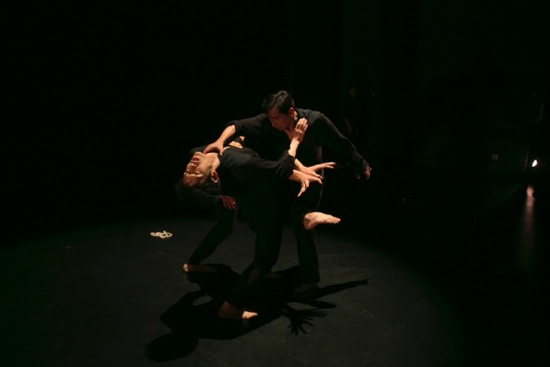
I-Nam Jiemvitayanukoon (L) and Luis Gabriel Zaragoza struggle in Anna Sokolow’s Steps of Silence. Photo: Melissa Sobel/Meems Images
Steps of Silence (reconstructed by Lauren Naslund) is also grim. It can be seen as a response to the war in Vietnam, which was just coming to an end. In the beginning, the dancers’ voices come out of darkness. It’s hard to make out what binds them together; their sentences, layering over each other, are personal, but imply restrictions (an approximate example: “They said, ‘don’t walk on the grass;’ they never said, ‘don’t fly above it’”). After the lights come on, we can see that the ten dancers, spread out over the stage, have their wrists bound together and are struggling against those cords. When they finally release themselves, they raise their hands as if to feel walls or ward off danger. The cords remain on the floor throughout the piece.
The accompanying music by Anatol Vieru is powerful, even heard on what sounds like mediocre equipment. It sometimes falls silent, and Petrilli’s lighting goes black at times. It’s as if we were watching separate snapshots. Two men (I-Nam Jiemvitayanukoon and Luis Gabriel Zaragoza struggle in slow motion until a third man (Boonyarith Pankamdech) stops them. In another pool of light, Zaragoza frantically scratches his skin (napalm perhaps?), reaches desperately up, and falls. Blackout. In another sequence, all but Scandola sit in a line facing the back wall. He walks, stiff and unseeing, along that line, reaching out a foot to step over each one’s legs; as he moves on, that person lies slowly down. The last three in the line fall together before he reaches them. Blackout. That’s how Sokolow distills a massacre.
In the end, after a spate of grappling and rushing, all have collapsed. A bell tolls. Newspapers blow in from stage left. These people’s final move is to clench, in unison, their positions. To protect themselves further? Or is this the Sokolowian interpretation of a death rattle? In any case, it grips your heart.
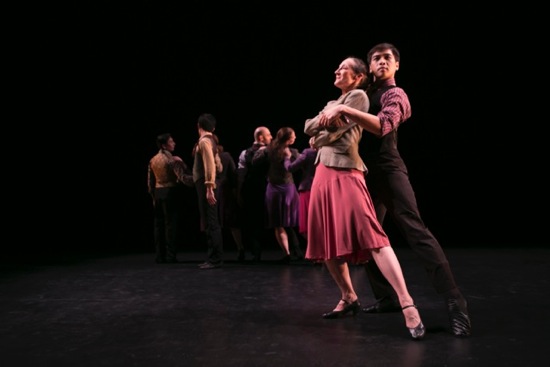
Anna Sokolow’s Kurt Weill. Foreground: Lauren Naslund and Boonyarith Pankamdech. At back (L to R): Luis Gabriel Zaragoza, I-Nam Jiemvitayanukoon, Richard Scandola, and Eleanor Bunker. Photo: Melissa Sobel/Meems Images
Kurt Weill, the third Sokolow work on the program, differs in several ways from the other two. Sokolow occasionally provided choreography for Broadway shows, made the dances for the original Off-Broadway production of Hair, and gave dance classes to actors at the Actors Studio. She knew how to create recognizable human dramas, if that was called for or if it interested her to do so.
However, Kurt Weill tells its “story” in her favorite suite form to music by Weill (notably the Brecht-Weill songs, “Surabaya Johnny” and “The Soldier’s Wife,” sung by PJ Harvey and by Marianne Faithfull). Sokolow had worked with Weill and also known his wife, Lotte Lenya. You can imagine the piece taking place in a seedy German dance hall between the two World Wars, with fascism on the rise. Eleanor Bunker, who staged the work, is also credited with the costumes: shirts, trousers, vests, and ties for the men (Jiemvitayanukoon, Pankamdech, Scandola, and Zaragoza) and short, solid-color dresses for the women.
At four of the six performances, the women in the cast are Bunker, Géracht, Naslund, and Francesca Todesco, and there’s a point to be made about costuming—so effective in Kurt Weill. Géracht and Naslund also performed with Rae Ballard in We Remember, a new trio choreographed by Ballard. In keeping with its title, it’s a short, spare, grave piece, but the three women who dance it wear distracting and unbecoming red-and-pink drapes over their pants and sleeveless tops (costumes by Ivana Drazie). Their garb appears out of keeping with the simplicity of the work. The four mature dancers in Kurt Weill perform with skill and conviction; wearing their plain dresses and dancing with the men in in this Sokolow work, they seem well cast and ageless.
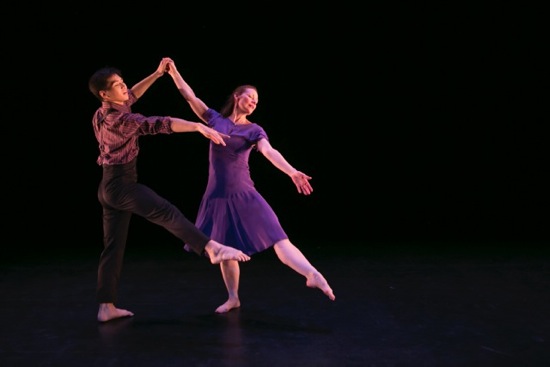
Boonyarith Pankamdech and Eleanor Bunker in Anna Sokolow’s Kurt Weill. Photo: Melissa Sobel/Meems Images
In this piece, Sokolow allows the dancers to look at one another and interact. With their ties loosened and their sleeves rolled up, the men swagger and exchange glances and strike macho attitudes. The women saunter and size them up. “Surabaya Johnny” is, after all, a song in which a woman repeats over and over her love for a man who beats her up. If a dancer in Kurt Weill jumps into a man’s arms, she’ll be dropped. On the other hand, these women lock their partners’ hands behind their (the women’s) backs and hold them there, which makes for some effectively rough-edged dancing.
What’s most compelling about Kurt Weill, however, is the way Sokolow deconstructs the tango, whose rhythms inform much of the choreography. At first, without traveling from their spot, the dancers gesture or stick out a leg sharply. And gradually, intermittently, familiar tango moves appear: the ballroom holds, the leg that knifes between a partner’s legs, the sharp changes of direction. There are contrasting vignettes. Géracht, Naslund, and Todesco move slowly to a melancholy waltz, opening their palms to display a red flower as a kind of stigmata. The men reappear wearing black outfits and helmets and stamping out a march. Bunker stands motionless, staring forward, while callously and one by one they dress her—putting her feet into high-heeled shoes, hanging a gold evening dress from her shoulders, slamming a cap onto her head, draping a heavy shawl around her. This is a fairly literal depiction of the gifts sent to the soldier’s wife in the song; the last “gift” is a mourning veil that all but covers her. And then it’s back to the tango.
The members of Sokolow Theatre/Dance Ensemble perform her works admirably, with a fervor and emotional nuance that she would have appreciated. Those not already named are Mary Karl, Maya Kite, Annalisa Ledson, Alexandra Pfister, Meggi Sweeney Smith, Melissa Sobel, and Brock Switzer.

Thank you for this beautifully descriptive review. There are still moments of timeless relevance in this work.
Deborah, your personal recollections of Sokolow deepen this discussion of the current performance. Thanks for you insights, perspective and descriptions that bring the dances to life for us.